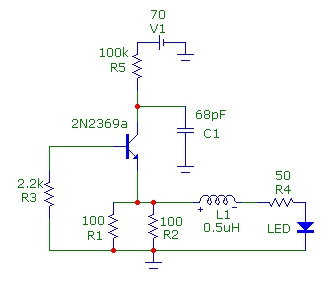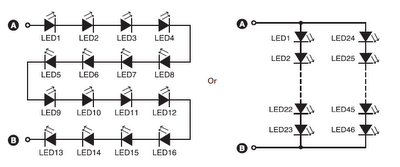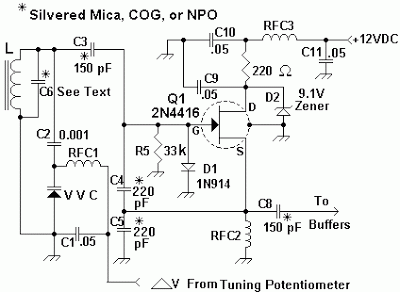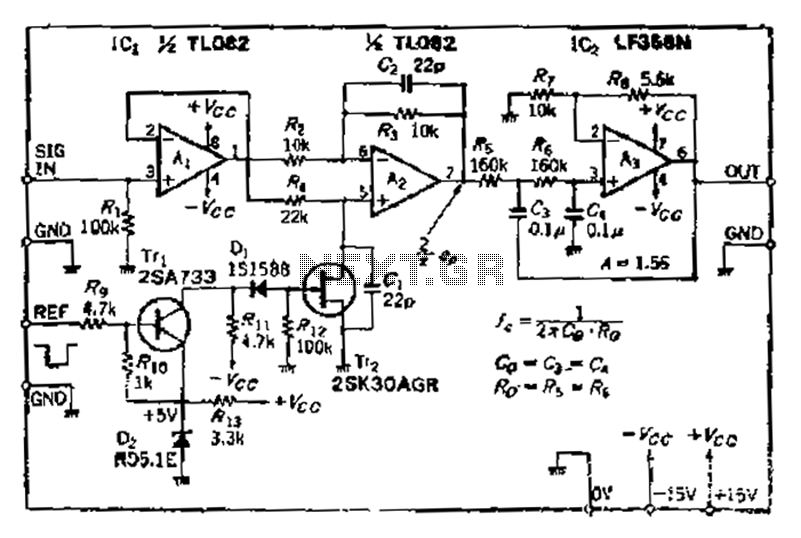
A Bedside Lamp Timer Circuit Schematic
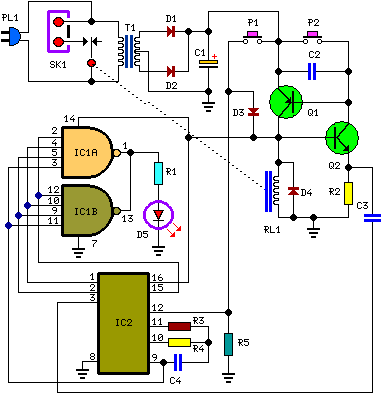
The purpose of this circuit is to power a lamp or other appliance for a specified duration (30 minutes in this case) and then automatically turn it off. This feature is particularly useful for reading in bed at night, as it allows the bedside lamp to turn off automatically if the reader falls asleep. After activation via the P1 pushbutton, an LED illuminates for approximately 25 minutes. Following this, the LED begins to blink for two minutes, pauses for two minutes, and blinks again for another two minutes before the lamp is switched off, serving as a signal that the on-time is nearing its end. If the user wishes to extend the reading time, they can press P1 again to gain an additional half-hour of light. The lamp can also be turned off at the user's discretion by pressing P2. Transistors Q1 and Q2 create an ALL-ON ALL-OFF circuit that, when in the off state, draws minimal current. The activation of the circuit is initiated by P1, which energizes the relay and powers the two integrated circuits (ICs). The relay switch controls the power to the lamp, while IC2 is reset with a positive voltage at pin 12. IC2 begins oscillating at a frequency determined by resistor R4 and capacitor C4. With the specified component values, pin 3 of IC2 goes high after approximately 30 minutes, which turns off the circuit through capacitor C3. During the six minutes leading up to the turn-off, the LED blinks as a result of connections from IC1 to pins 1, 2, and 15 of IC2. The blinking frequency is generated by the oscillator in IC2 at pin 9. The two gates of IC1 are connected in parallel to provide additional current. If desired, a piezo sounder can be connected to pins 1 and 14 of IC1. It is important to note that the timing can be adjusted by changing the values of C4 and/or R4.
This circuit utilizes a simple yet effective design to manage the operation of a lamp, incorporating user-friendly features for convenience. The primary components include two integrated circuits, a relay, resistors, and capacitors, which work together to create a timed switch. The use of transistors Q1 and Q2 ensures low power consumption when the circuit is inactive, which is crucial for energy efficiency.
The pushbutton P1 acts as the primary control for initiating the circuit, while P2 provides an immediate off function, allowing users to control the lamp without needing to wait for the timer to expire. The LED indicator serves a dual purpose by providing visual feedback when the lamp is in operation and signaling the impending shut-off through its blinking pattern.
The timing mechanism relies on the RC timing circuit formed by R4 and C4, which determines the duration of the lamp's operation and the blinking intervals. Adjusting these components allows for customization of the timing to suit different user preferences. Additionally, the option to include a piezo sounder adds an auditory signal to the visual feedback, further enhancing user awareness of the lamp's status.
Overall, this circuit exemplifies a practical application of basic electronic components to create a useful device for everyday scenarios, particularly in settings where automated control of lighting is beneficial.The purpose of this circuit is to power a lamp or other appliance for a given time (30 minutes in this case), and then to turn it off. It is useful when reading at bed by night, turning off the bedside lamp automatically in case the reader falls asleep.
After turn-on by P1 pushbutton, the LED illuminates for around 25 minutes, but then it starts t o blink for two minutes, stops blinking for two minutes and blinks for another two just before switching the lamp off, thus signaling that the on-time is ending. If the user want to prolong the reading, he/she can earn another half-hour of light by pushing on P1.
Turning-off the lamp at user`s ease is obtained by pushing on P2. Q1 and Q2 form an ALL-ON ALL-OFF circuit that in the off state draws no significant current. P1 starts the circuit, the relay is turned on and the two ICs are powered. The lamp is powered by the relay switch, and IC2 is reset with a positive voltage at pin 12. IC2 starts oscillating at a frequency set by R4 and C4. With the values shown, pin 3 goes high after around 30 minutes, turning off the circuit via C3. During the c6 minutes preceding turn-off. The LED does a blinking action by connections of IC1 to pins 1, 2 & 15 of IC2. Blinking frequency is provided by IC2 oscillator at pin 9. The two gates of IC1 are wired in parallel to source more current. If required, a piezo sounder can be connected to pins 1 & 14 of IC1. Obviously, timings can be varied changing C4 and/or R4 values. 🔗 External reference
This circuit utilizes a simple yet effective design to manage the operation of a lamp, incorporating user-friendly features for convenience. The primary components include two integrated circuits, a relay, resistors, and capacitors, which work together to create a timed switch. The use of transistors Q1 and Q2 ensures low power consumption when the circuit is inactive, which is crucial for energy efficiency.
The pushbutton P1 acts as the primary control for initiating the circuit, while P2 provides an immediate off function, allowing users to control the lamp without needing to wait for the timer to expire. The LED indicator serves a dual purpose by providing visual feedback when the lamp is in operation and signaling the impending shut-off through its blinking pattern.
The timing mechanism relies on the RC timing circuit formed by R4 and C4, which determines the duration of the lamp's operation and the blinking intervals. Adjusting these components allows for customization of the timing to suit different user preferences. Additionally, the option to include a piezo sounder adds an auditory signal to the visual feedback, further enhancing user awareness of the lamp's status.
Overall, this circuit exemplifies a practical application of basic electronic components to create a useful device for everyday scenarios, particularly in settings where automated control of lighting is beneficial.The purpose of this circuit is to power a lamp or other appliance for a given time (30 minutes in this case), and then to turn it off. It is useful when reading at bed by night, turning off the bedside lamp automatically in case the reader falls asleep.
After turn-on by P1 pushbutton, the LED illuminates for around 25 minutes, but then it starts t o blink for two minutes, stops blinking for two minutes and blinks for another two just before switching the lamp off, thus signaling that the on-time is ending. If the user want to prolong the reading, he/she can earn another half-hour of light by pushing on P1.
Turning-off the lamp at user`s ease is obtained by pushing on P2. Q1 and Q2 form an ALL-ON ALL-OFF circuit that in the off state draws no significant current. P1 starts the circuit, the relay is turned on and the two ICs are powered. The lamp is powered by the relay switch, and IC2 is reset with a positive voltage at pin 12. IC2 starts oscillating at a frequency set by R4 and C4. With the values shown, pin 3 goes high after around 30 minutes, turning off the circuit via C3. During the c6 minutes preceding turn-off. The LED does a blinking action by connections of IC1 to pins 1, 2 & 15 of IC2. Blinking frequency is provided by IC2 oscillator at pin 9. The two gates of IC1 are wired in parallel to source more current. If required, a piezo sounder can be connected to pins 1 & 14 of IC1. Obviously, timings can be varied changing C4 and/or R4 values. 🔗 External reference
